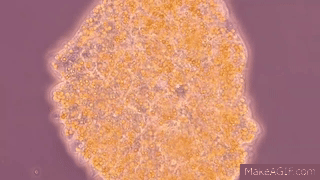 |
| Image 1 from Ref 5 |
 |
| Image 2 from Ref 5 |
 |
| Image 3 from Ref 5 |
 |
| Image 4 from Ref 3 |
Post detection treatment varies on the stage and type of
infection. With chronic infections that flare up after secondary immune
compromise events, prolonged treatments with antifungals will occur for about a
year (1) (5). Chronic infections have different styles, however treatment will
stay the same for all chronic infections with any variance being on medication
dosage levels (3) (6). The worse stage of chronic infection is when the yeast
becomes disseminated and spreads through the blood to other organs and tissues,
which is known as a systemic infection. This stage is very lethal if left
untreated due to potential systemic organ failure, however treatment in patients
that do not suffer irreversible damage to their tissue is extremely successful
(5) (6). Subsequent medications of balancers might be utilized for later stages
of this, however antifungals of the same style will be utilized. Due to the
reclusive nature of the microbe in undetected stages, it remains hard to detect
and subsequently treat it (6). A good reference is that in cases of greater
infection, symptoms from H. capsulatum
will occur which allows for detection and subsequent treatment.
A key reminder is that the elderly and adolescents pose a
higher risk of acute infections due to structurally weaker immune systems.
Awareness of the microbe and its symptoms can lead to proper detection and
subsequent treatment of such individuals at higher risk.
Prevention of infections is a seemingly coordinated effort
for H. capsulatum. Prevention of
accumulated bird or bat droppings near opportune soil environments is a
combined effort. Within working environments with higher risk, utilization of
greater personal protective equipment (PPE) is vital to preventing potential
infections. Awareness of areas containing high concentrations of bats and birds
is a great advantage in the field of prevention. Contrary to land birds,
aquatic birds such as gulls, provide no threat to infection. As with most
infections that spike in immune-compromisation, keeping a healthy immune system
is vital in preventing more harmful and serious infections (5) (7). Proper
diet, sleep patterns, and proper actions within the state of being sick are
crucial for preventing a weakening of the immune system. A key thing to note in
this is that infections leading to sickness can weaken an immune system to the
point where different subsequent microbes, such as H. capsulatum, are allowed to have a more opportune impact on a
host. Proper health measures during illness, such as sleeping enough and eating
well are crucial for preventing subsequent infections from other microbes (5). With
acquired immune deficiency syndrome (AIDS) at pandemic levels, and fungal
vaccines still in developmental stages, proper preventative measures prove
highly effective for preventing such a microbe from having a high impact on the
population. (1)
To summarize, H.
capsulatum resides in the central US with 5 – 20% of lifetime residents
obtaining chronic infections. Soil frequented by birds, bats, and livestock
pose a higher risk, so be aware with frequenting these areas in the ideal
temperature range (77 degrees), since any walking can release spores. Infection
will occur in the lungs and can eventually progress to a systemic infection. Asymptomatic
chronic infections are frequent and these are problematic if your immune system
is weakened by future infections. Symptomatic infections will result fairly
recent after infection and seeking of a physician is important to prevent a
systemic infection. The key factor with infection of H. capsulatum is prevention of a systemic infection, which can be
avoided by being aware of symptoms and seeking of medical assistance. Be aware that elderly, adolescent, and
immune-compromised individuals (AIDS) are at a higher risk of infection, and
observe symptoms in those individuals if they arise while encouraging seeking
medical treatment. Keeping a healthy immune system through sleeping, eating,
and exercising properly is a key factor in managing infections and should be
done regardless.
References:
(1) Medici, Natasha P., and Maurizio Del Poeta. "New Insights on
the Development of Fungal Vaccines: From Immunity to Recent
Challenges." Mem. Inst. Oswaldo Cruz Memórias Do Instituto
Oswaldo Cruz 110.8 (2015): 966-73. Web.
(2) Bossche, Hugo, Frank Odds, and David Kerridge.
Dimorphic Fungi in Biology and Medicine. 1st ed. New York and London: Plenum
Press, 1993
(3) Chang, Ryan. "Histoplasmosis." 19
Sep 2005. emedicine. 25 Aug 2007 <http://www.emedicine.com/MED/topic1021.htm>.
(4) Heitman, Joseph, Scott G. Filler, Aaron P.
Mitchell, and John E. Edwards, Jr.Molecular Principles of Fungal Pathogenesis.
1st ed. New York: ASM Press, 2006. (Heitman et al. 611-626)
(5) "Histoplasmosis." Centers for
Disease Control and Prevention. 12 Oct 2005. Centers for Disease Control and
Prevention. 25 Aug 2007 <http://www.cdc.gov/ncidod/dbmd/diseaseinfo/histoplasmosis_g.htm>.
(6) Kobayashi, George S.. "Molecular Basis of
Adaptation in Histoplasma capsulatum ." Washington University School of
Medicine. 25 Aug 2007 <http://research.medicine.wustl.edu/OCFR/Research.nsf/Abstracts/64ABA9996B650C50862567ED00029E69?OpenDocument&VW=Infectious+Diseases>.
(7) Lai, Chung-Hsu,
Chun-Kai Huang, Chuen Chin, Ya-Ting Yang, and Hsiu-Fang Lin. "Indigenous
Case of Disseminated Histoplasmosis, Taiwan." Emerging Infectious Diseases
Jan 2007 127-129.














